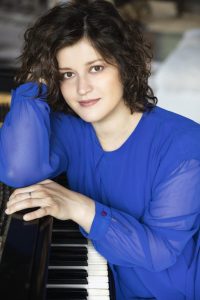
By Márcio Bezerra
The Society of the Four Arts hosted pianist Anna Geniushene on Wednesday in a program of firsts.
The young artist, whose career has been growing silver she won the silver medal at the 2022 Van Cliburn Competition, presented a clever program that consisted of several Opus 1 by composers from the classical period to the twentieth century.
To be clear, an Opus One is not necessarily the first attempt of composition, but the first edited work by a particular composer. In any case, it was enlightening to see how composers’ first published works would compare to their more mature pieces. But, to a point! (more on that later).
The program started with 18th-century pianist Muzio Clementi, a composer absent on most programs, even though his sonatinas are performed by thousands of young pianists in end-of the-year recitals.
In Clementi’s case, his Opus 1 was also a work of very young years (he was 12 years old), a Sonata in E-flat major, Op. 1, no. 1. A charming piece written in the galant style, it received a careful reading by Geniushene. Her supple technique shone from the first measures, although her choices of dynamics and rubato were somewhat exaggerated and, perhaps, out of style.
She was more in her element with the next works, mostly drawn from the Romantic period. In Frédéric Chopin’s Rondo in C minor, Op. 1, her playing of the many filigree passages was polished and colorful, and she made every effort to deliver this less-than-successful first published work by the Polish master in a better light than it deserves.
She also gave authoritative performances of the delicate Lullaby, Op. 1, by another Polish composer, Miecyszlaw Weinberg as well as of the virtuosic and, at times operatic, Two Pieces, Op. 1 by Pyotr Tchaikovsky.
Alas, there was a major flaw of the lineup in the first half, as interesting as the idea was: For over 50 minutes, one had to endure a succession of immature, tentative, and at times presumptuous works.
One exception was the delightful Variations on the Name “Abegg,” Op. 1, by Robert Schumann. Once again, Geniushene displayed a tonal palette of many colors. Her facility in playing fast passagework was impressive, as well as her control of voicing.
The second half of the program brought better music, as she tackled Alban Berg’s Sonata, Op. 1. The fact that this unique exemplar in Berg’s output is often performed to this day attests to the higher quality of his first publication. It is a highly expressive work, unabashedly chromatic or “softly” atonal, making it more akin to late Romantic experiments than to the Second Viennese School’s highly cerebral short pieces.
Curiously, Geniushene’s approach was the least successful of the evening. Surely, she had no technical difficulties, but her rhapsodic rendition did not help to hold the work together.
Not surprisingly, she was very successful in the last work on the program, Johannes Brahms’ Sonata in C Major, Op. 1.
Now, this is not a péché de jeunesse but a masterful work in which Brahms tried to equate himself with the towering figure of Beethoven. He came very close.
How this provincial kid from a then provincial Hamburg could exploit motivic variation and development at this level, at the age of twenty, is nothing short of astounding. In fact, upon hearing him playing his Op. 1 the day the young composer walked into the Schumann’s house, Robert wrote in his diary, “Brahms from Hamburg — a genius,” while Clara remarked “Here again is one who comes as if sent from God. He played us sonatas, scherzos etc, of his own, all of them showing exuberant imagination, depth of feeling, and mastery of form.”
Geniushene’s interpretation was one the highlights of the season. She negotiated the fiercely difficult fast movements with romantic élan, astounding sound, and finesse, especially in her signature use of the una corda pedal that achieved a true vocal sotto voce effect. Her singing of the second movement reached moments of true beauty.
It was a special moment since this sonata is not performed often due to its difficulty and to the fact that the mature Brahms became a very different composer as he focused his attention to sets of miniatures in which a longing lyricism arrived at unmatched heights.
All in all, a very informative program performed by a master of her instrument. But one would have enjoyed her artistry even more if she had chosen an Opus 10 program instead.